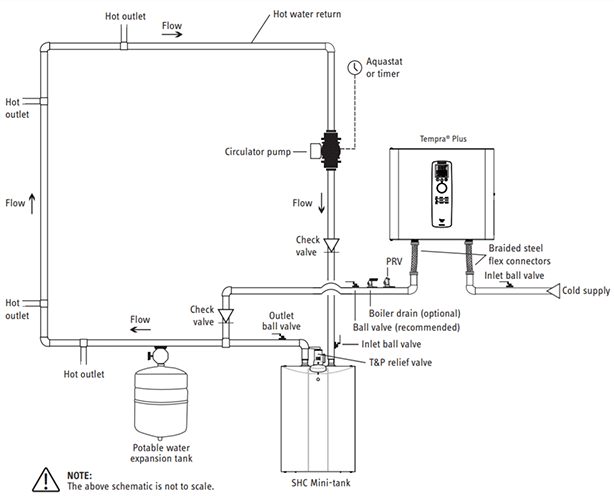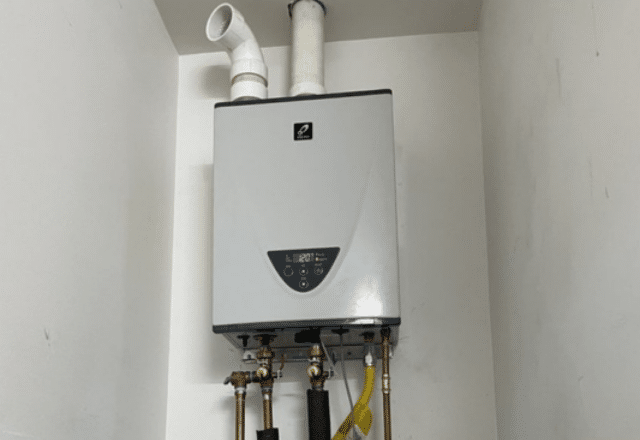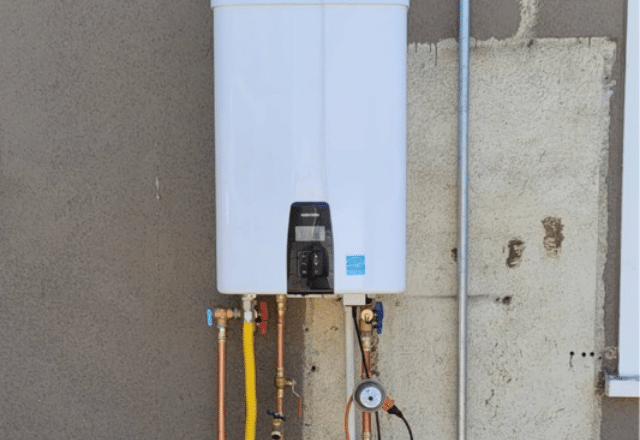
Tankless water heaters, particularly electric tankless water heaters, are gaining popularity due to their efficiency and ability to provide hot water on demand. Unlike traditional water heaters that continuously heat and store water, tankless models heat water instantly as it flows through the unit. This on-demand system results in significant energy savings by reducing energy costs and consumption. Electric tankless water heaters are known for their energy efficiency, which not only benefits the environment but also lowers household energy bills. The key to their efficiency lies in eliminating the need to keep a large tank of water heated at all times, thus offering an energy-efficient and affordable solution to your hot water needs.
For electric tankless water heaters, the EcoSmart ECO 11 is often considered one of the easier models to install. It’s compact, lightweight, and has simple plumbing connections. However, it’s important to note that you may still need an electrician since it requires a 240V connection.
For gas tankless water heaters, the Rinnai RU199iN is relatively straightforward to install if you’re replacing an existing gas water heater. It comes with clear installation instructions and standard connections.
First, shut off all power at the circuit breaker and turn off the main water supply. Drain the existing water system by opening faucets.
Next, mount the tankless unit on the wall, ensuring it’s level and secure. The location should be close to your electrical panel and have proper ventilation. Most units come with a mounting bracket – make sure it’s properly anchored into wall studs.
For the plumbing connections, install shut-off valves on both cold water inlet and hot water outlet lines. Connect the cold and hot water lines to the unit using the appropriate fittings (typically 3/4″ NPT connections). Be sure to use thread tape on all connections to prevent leaks.
For electrical work, install a dedicated double-pole circuit breaker in your panel (typically 240V, with amperage matching the heater’s requirements). Run the appropriate gauge electrical wire from the panel to the unit. Make the electrical connections according to the manufacturer’s wiring diagram – this usually involves connecting two hot wires, a neutral, and a ground wire.
Finally, restore power and water supply. Open each faucet one at a time to purge air from the lines. Check all connections for leaks and test the unit’s temperature settings.

Before installing a tankless water heater, it’s important to carefully consider several factors to ensure a successful installation.
Making an informed decision about these aspects is essential to ensure that your tankless water heater installation goes smoothly and efficiently, providing you with a reliable source of hot water for years to come.
The installation process for a tankless electric water heater involves a series of carefully executed steps. Adhering to these steps ensures efficient performance and compliance with safety standards:

For a successful installation of a tankless electric water heater, you’ll need specific tools and equipment:
Having these tools on hand will facilitate a smoother installation process and help in achieving a properly functioning tankless electric water heater.
Installing a tankless electric water heater involves several additional components that ensure the system’s safety and efficiency:

The electrical setup is a critical aspect of installing electric tankless heaters:

For the electrical hookup: Connect the unit to your electrical panel using the proper gauge wire (usually 6 or 8 gauge for 240V). You’ll need to connect two hot wires (typically red and black) to the main terminals, a neutral wire (white), and a ground wire (green or bare copper). Make sure you’re using a double-pole circuit breaker rated for the heater’s amperage requirements.
For the water connections: On the bottom of the unit, you’ll find two water connections. The cold water inlet is typically marked with blue and the hot water outlet with red. Install shut-off valves on both lines for maintenance. Use 3/4″ NPT fittings and plumber’s tape on the threads to prevent leaks. Connect the cold water supply to the inlet (blue) and your home’s hot water line to the outlet (red).
When installing a tankless electric water heater, it’s crucial to follow strict safety precautions and comply with local building codes:

Once you’ve ensured safety and compliance, the next steps involve connecting and setting up the heater:
These steps will help you set up your tankless electric water heater correctly, ensuring it provides a consistent and efficient supply of hot water.
Once the heater is installed, follow these final steps to ensure it operates correctly:
By meticulously following these steps and testing the setup, you can ensure the safe and efficient operation of your new tankless electric water heater. If you require professional assistance with installation, reach out to 5 Star Plumbing for help.
Low cost water heater replacement and cheap hot water heater repair services are often available near you. When searching for the cheapest water heater installation near you, it’s important to balance affordability with quality to ensure you get a reliable and efficient system.
While many believe garbage disposals can handle any food waste, this is a common misconception that leads to problems. Certain items will consistently cause clogs and should never enter your disposal.
Hard items like bones, pits, corncobs, seeds, and ice cubes can damage or jam the disposal’s grinding mechanism. Similarly, fibrous materials such as pasta, celery, asparagus, corn husks or silk, lettuce, and banana peels can wrap around the disposal’s components and cause malfunction.
A major issue occurs when potato peels clog drains, as these starchy vegetables create a paste-like substance when ground up. When potato skins in garbage disposal units combine with water, they form a thick, sticky mixture similar to what happens with grease and fat. Additionally, knowing how to unclog eggshells in garbage disposal units is crucial, as they create tiny, granulated particles that stick in crevices and accumulate over time. Like eggshells, coffee grounds can also compact into tight spaces, leading to stubborn clogs.
Grease, fats, and oils are particularly problematic because they solidify as they cool, creating blockages that prevent proper water flow and waste disposal. When combined with other food particles, these substances can create extremely difficult clogs to remove.
I bring over 9 years of dedicated plumbing experience to the table. As a seasoned professional in the plumbing industry, I've tackled a wide range of projects, from residential repairs to large-scale commercial installations.

